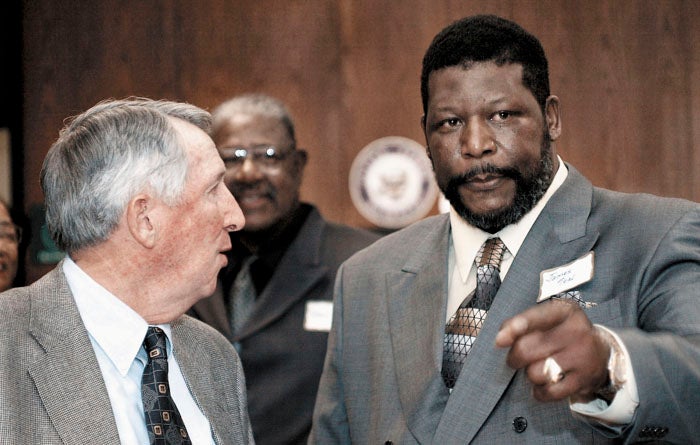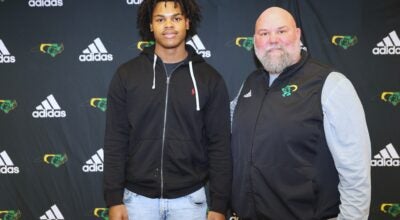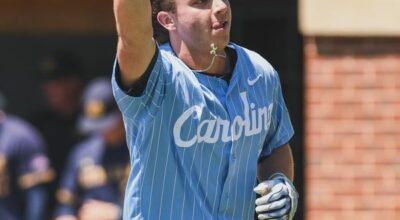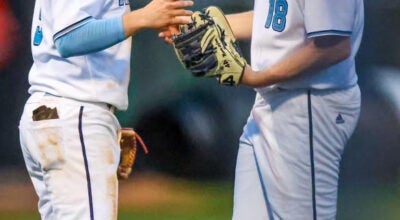Sports obituary: Hall of Famer James Teal was pioneer for Black Rowan athletes
Published 12:01 am Sunday, January 2, 2022

- James Teal, right, is seen with coach Bob Pharr - Salisbury Post file photo by Joey Benton
By Mike London
mike.london@salisburypost.com
Known as “The Quiet Man” in his days as the leading tackler for Purdue University, Salisbury-Rowan Hall of Famer James Franklin Teal passed away at 71 shortly before Christmas in Farmington Hills, Michigan.
Friends and teammates of Teal’s in Salisbury received the news of his passing.
Teal was among the first Black athletes in Rowan County to attend one of the traditionally all-white schools. He played for the Boyden Yellow Jackets from 1965-67, a few years before it became Salisbury High.
He was the first Black player to represent Rowan County in the Shrine Bowl of the Carolinas and the first to be named to the Greensboro News and Record’s All-State team. That was regarded as the official All-State team in that era.
Teal played offensive tackle as a sophomore and guard as a junior. As a senior, he primarily played defense for the first time, and that proved to be his calling. He loved to hit people and he was a sure tackler.
There was quite an uproar in the North Carolina media after Myers Park’s Jimmy Lee Kirkpatrick, who was widely considered the state’s best back, was snubbed for the all-white 1965 Shrine Bowl squad. That led to change. Two Blacks were chosen for the 1966 North Carolina roster.
Teal was one of four Black players on the 1967 North Carolina team. He weighed a modest 200 pounds then, but wearing the No. 50 jersey, he was stood out both ways as a guard on offense and linebacker on defense.
He never forgot Shrine Bowl week.
“I remember it because everyone on our team had abilities, everyone was talented,” Teal said in a 2017 interview. “But I remember visiting the kids in the Shriner’s Hospital more than the game. Those kids grabbed your heart.”
Teal’s mother worked as a live-in maid in New York, and she couldn’t have a child with her, so Teal came to live with his aunt and uncle on Standish Street in Salisbury, near Livingstone College. J.C. Price, the school for Black students in Salisbury, was within easy walking distance for Teal.
“I grew up with the dream of playing tight end for Price,” Teal said. “But as a freshman at Price, I got kicked off the team.”Teal remembers getting a cut on a cinder track that led to an infected knee. Teal usually ran laps up front at Price’s practices, but that bum knee had him running at the rear. His struggle was perceived as laziness. He was dismissed from the squad.
“I really wanted to play football,” Teal said. “The only option was Boyden.”
Boyden was still playing in the 4A ranks in 1965 and struggled to a 3-7 record Teal’s sophomore year.
A new staff, headed by Pete Stout, took over prior to the 1966 season.
“I still wanted to play tight end and catch passes,” Teal said. “First hour of the first day, we’re hitting those practice dummies, and I told (assistant coach) Charlie Little that I was a tight end. He stared at me and said, ‘You’re my guard.'”
Boyden went 6-3-2 and made the playoffs.
“Coach Stout was a good coach,” Teal said. “He understood leverage, angles, footwork. That’s one of the reasons I was able to advance as far as I did in the game.”
In 1967, Teal’s senior year, Boyden played a much different schedule as a member of the Western North Carolina High School Activities Association, but the South Piedmont Conference was a tough league. Boyden went 5-4-1. Teal made All-SPC and All-Rowan County. In addition to being on the Shrine Bowl team, he was an honorable mention All-American.
“I wore one of those big forearm pads, and I wrote ‘Ouch!’ on it — and big enough to be seen,” Teal said.
Teal’s dream school was the University of North Carolina. UNC signed its first Black scholarship football player, Ricky Lanier, in 1967, but in the spring of 1968 when Teal was making his college decision, opportunities were still limited for Black players in the ACC and SEC.
Teal drew a lot of attention from the Big Ten. Fully integrated and with black stars at most of its schools, the Big Ten probably was the nation’s strongest league then and was a magnet for Black athletes from the South.
Purdue signed Teal partly because assistant coach Don Fuoss had played at Catawba College and had married a Salisbury girl. Fuoss made landing Teal a top priority. Teal turned down Ohio State, among others.
“When Purdue started recruiting me, they had just won the Rose Bowl with Bob Griese and they were one of the best programs in the country,” Teal said. “But once I got to Purdue, it was Ohio State going to the Rose Bowl just about every year.”
At Purdue, he was known as Jimmy or Jim, rather than James.
He toiled on the offensive line for a shaky Purdue freshman team.
“I finally convinced the coaches that I was too small to play on the offensive line in the Big Ten,” Teal said. “I told them I needed to move over to defense.They gave me a chance to try out at outside linebacker.”
The rest is history. Teal came out of nowhere to earn a starting berth as a Purdue sophomore. He started three years.
“It was picture day (1969), and they called me out there as a first-string linebacker,” Teal said.
He never forgot that feeling.
As a junior, Teal was Purdue’s leading tackler with 122 stops. As a senior, he was a captain.
He earned All-Big Ten accolades and he remains one of the top tacklers in Purdue history with 294. Most of the players ahead of Teal on the all-time list had the benefit of playing four seasons, but he did what he did in three.
“We played tough teams,” Teal said. “The biggest rivalries for us were the other schools in Indiana — IU and Notre Dame. The toughest player I went up against was (Michigan guard) Reggie McKenzie. We went at it for years. He was in the NFL a long time for a reason.”
The 17 rounds of the 1972 NFL Draft were held over a two-day period in early February in New York City. McKenzie went to the Buffalo Bills to start the second round and would become famous blocking for O.J. Simpson.
Teal had to wait longer to be drafted. In the 10th round, Teal became a Detroit Lion.
“I would’ve made the Lions in 1972, but I tore an ACL in the last preseason game,” Teal said. “Sports medicine and technology then weren’t what they would become. My ligament had snapped in two, and they took that ligament and just stapled it to my knee. They put me in a cast, hip-to-toes, and I faced a long recovery period.”
He was never quite the same, but he was good enough to make the Lions in 1973 as a 215-pound linebacker.
“I was the first replacement at both outside linebacker spots and I played on special teams,” Teal said. “I made my mark on special teams. I tried to be the first one down the field.”
That was an average Lions team, remembered mostly for two superstars — DB Lem Barney (56 career interceptions) and tight end Charlie Sanders (31 TDs).
“Sanders taught me more than anyone,” Teal said. “All the way back to high school, I’d always hit the guy across from me in the head with my forearm, just dazed him a little. That would be a penalty now, but that’s how you played the game then. But when I hit Sanders with my forearm, he’d just grab it, and throw me to the ground. He told me I needed to figure out something else.”
Teal’s time with the Lions was brief. There was a dispute over his pay. He filed a grievance with the NFL Players Association. That’s not the sort of thing a team is going to let slide, not when it’s a rookie backup making the claim. Teal was traded to the Los Angeles Rams.
That ended up being a positive for Teal. One of the Rams had just been signed by the Birmingham franchise in the new World Football League. Birmingham needed a linebacker and signed Teal. He played for the Birmingham Americans (1974) and the Birmingham Vulcans (1975) at Legion Field.
Teal’s 1974 club won the World Bowl. His 1975 team had the best record (9-3) in the league. That’s when the WFL folded.
He finished his playing career in 1977 in the Canadian Football League with the Ottawa Rough Riders.
Teal was elected to the Salisbury-Rowan Hall of Fame in 2002, entering as part of a stellar class that included Walt Baker, Vern Benson, Jimmy Heggins, David Drechsler, Larry Thomason and Bobby Pharr, who was Teal’s basketball coach at Boyden. Teal was pretty good in hoops. He scored 24 points one night and averaged 10.4 points for Pharr as a senior. He also competed in track and field.
Teal made a name for himself in the sports world when the odds were stacked against him.





